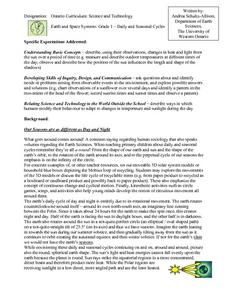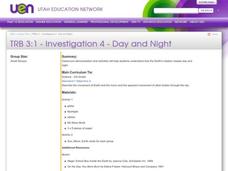Curated OER
Solar System 2
In this space worksheet, students identify and locate vocabulary terms and names related to the Solar System. There are 31 words located in the puzzle.
Curated OER
Earth And Beyond
For this earth and space worksheet, students identify and locate vocabulary terms and names related to earth and space sciences. There are 53 words located in the puzzle.
Curated OER
Orbit, rotation, revolution of Earth
Eighth graders define orbit, rotation and revolution. They demonstrate the orbit, rotation and revolution of the Earth. Students identify the types of measurements and the instruments that used for orbit, rotation and revolution. They...
Curated OER
The Voyage Scale
Pupils identify how models are powerful tools of exploration and that the sizes of the planets and distances between the planets in the Solar System span a large range. They make a sign for each planet they have created in the lesson...
Curated OER
Science: Daily and Seasonal Cycles
First graders use their observations to describe daily and seasonal cycles. through a demonstration using a suspended ball and flashlight, they determine the time of day in various locations. Next, 1st graders participate in a...
Curated OER
Planetary Mobile
Students receive pre-cut templates of cardboard with appropriate diameters of each planet and the sun. They use multi-colored construction paper, scissors, yarn, and other art supplies to create their own models of planets. When students...
Curated OER
Earth and Sun's Distance
Students consider the shape of the Earth's orbit around the Sun. They view the first segment of Science Court video and use Timeliner software to construct a scale of the distance between the Earth and the Sun.
Curated OER
TE Activity: A Roundabout Way to Mars
Students investigate Hohmann orbit transfers using cardboard and string while focusing on the orbits of Earth and Mars. They look at the planets orbits around the sun and transfer orbit form one planet to another to determine what a...
Curated OER
Let's Think About Day and Night
Students explore day and night and the relationships between the Earth, the sun and the moon. They discuss the ways in which the sun and moon help us. They watch a short video that helps illustrate these concepts.
Curated OER
Modeling Martian Motion
Students explore the difference between stars and planets and take on the role of these objects to simulate the relative motions of Mars and the Earth around the Sun.
Curated OER
Comets and Meteors
Students construct a model of a comet nucleus using dry ice. They add other materials and describe the features. They complete related exercises on an Internet Web site.
Curated OER
Day and Night
Third graders view a classroom simulation that demonstrates how the Earth's rotation creates day and night.
University of Arizona
The Exotic Vacation
Students explain the concepts and vocabulary of Earth's rotation. They plan imaginary vacations based on the seasons in different locations. This is a very creative lesson plan, which students enjoy.
Curated OER
Distance And Parallax
Students will determine distances to nearby stars using parallax. In this Astronomy lesson plan, students will use a web program, trigonometry, and sketches to determine the distance of stars.
Curated OER
Cassini gets Ready to run Rings Around Saturn
Fourth graders study an article about Saturn. In this investigative lesson students discuss the article and complete an activity that asks them what question they would pose about Saturn.
Curated OER
Sun too close? We'll just change Earth's orbit
Students study an article and discuss what would happen if the Earth's orbit changed. In this Earth's orbit lesson students answer a list of questions and complete an activity.
Curated OER
A Lunar Transit of the Sun from Space
In this moon worksheet, students determine the angular size of the moon and draw a scaled model of the Earth, moon, and sun and given distances and positions. This worksheet has 4 problems to solve.
Curated OER
Artificial Satellites and Space Probes
In this satellites worksheet, students match the list of facts given with the artificial satellite or space probe that it describes. This worksheet has 12 matching questions.
Curated OER
How Does Earth Move?
In this earth movement instructional activity, students will fill in the blank of 4 statements relating to how the Earth spins on its axis and how it moves around the sun.
Curated OER
How Does the Moon Move?
In this moon worksheet, learners will fill in the blank of 6 statements relating to how the moon rotates around the Earth including the phases of the moon.
Curated OER
Orbit an Artificial Satellite
Students construct an artificial satellite from random materials. They demonstrate the principle of an orbit. Students are divided into small groups. Each group creates a model of an artificial satellite in orbit.
Curated OER
Cosmic Collisions and Risk Assessment
In groups, students create their own scientific impact experiments using ordinary materials, and observe and measure results with a variety of impacting bodies and velocities.
Curated OER
As the World Turns
Third graders read books and participate in class discussions about the motion of the stars and planets and moons in relation to the Earth. In small groups, 3rd graders act out these movements to music.

























